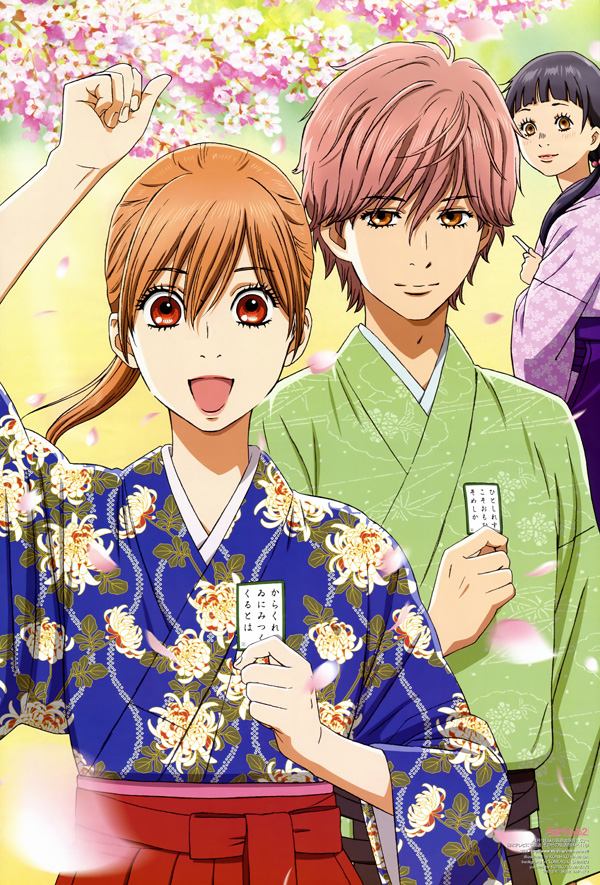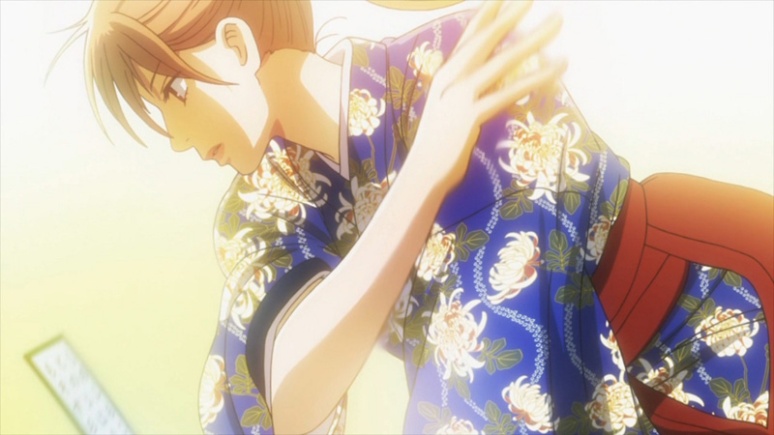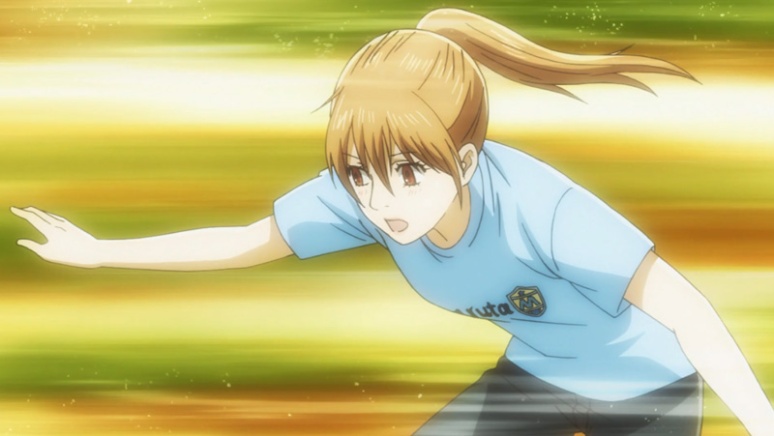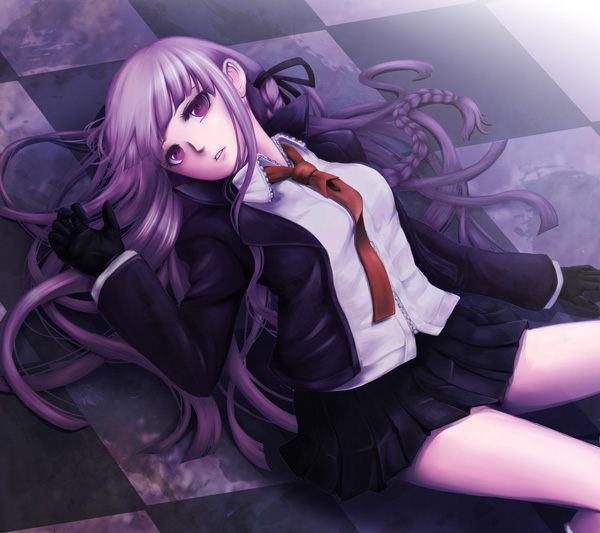![Natsume.Yuujinchou.full.1443792]()
Backlogs, who wouldn’t have them? Especially with time constraints, backlogs tend to grow overwhelmingly huge over the long term and before we know it, we are faced with an almost unbreakable wall of piled up unwatched anime.
During the winter season, I decided to pick as less anime as possible since I want to catch up on some old ones. For better or for worse, there are more good 20+ episodes anime then I thought from the previous Fall season, where I was forced to contribute more of my time for during my “winter session.” In the end, I wasn’t even able to finish through halfway of the anime in my backlog but either way, I’m still happy with my progress, which I think it’s a pretty good achievement considering how restricted my free time is nowadays. Here are some anime I finished, and my impressions on them (Note: For all these shows, I mostly finished all of these, and even multiple seasons if available, I however didn’t watch any bonus episodes, OVA, etc..)
![Sayonara.Zetsubou.Sensei.full.18408]()
Sayonara Zatsubou Sensei (season 1 to 3)
I marathon all of them in a row, and I can only asked myself “Why didn’t I watch it earlier?” It’s definitely not Gintama, but it’s still a great anime, and portrays jokes in a manner quite similar, yet very different then that of Gintama. Philosophical humors are always present as you follows Itoshiki Nozomu, a young man who even the slightest negativity causes him the urge to commit suicide. Such a man became a high school teacher, instilling his extreme negativity and despair to his own students.
While being a comedy, each episode Sayonara Zetsubou Sensei mostly talks about minor but intriguing concepts and themes, and I’m sure if I were watching anime earlier, and chances are, if I’m blogging earlier too, I would write tons of posts on them. “SZS: Trivial Details instead of Main Subject – A Study of Aesthetics of the Human Eye”, “SZS: A “Duty” To Serve Expectations”, “SZS: The Aspect of a Third Choice”, “SZS: Optimism and Pessimism” and so on. Just look at all the cool titles I can come up with, I would totally write them just from these cool titles alone.
There are a lot of great soundtracks too. From some literally despair-instilling track, to some oddly peaceful ballads and even some piano and violin solos, the albums of Sayonara Zetsubou Sensei is noteworthy. Of cause, the anime is by Shaft, and they are most known for their interesting symbolism, vague representations and dialogue-focused sequences. If you like Bakemonogatari, I’m sure you would love all these aspects of Sayonara Zetsubou Sensei too.
And I heard the manga had a shocking ending too, so shocking that it left all it’s readers in despair. I’m going to read it soon too, so that I can attain an even higher level of despair…
![Natsume.Yuujinchou.full.1388995]()
Natsume Yuujinchou (season 1 to 4)
Natsume Yuujinchou is one of those anime which I had weirdly left out in my backlog for a considerable long amount of time, despite the popularity the franchise had. Natsume Yuujinchou tells the tales of a young boy who can see youkai, and the best part of the anime is his interactions and relations with both humans and youkai. As a “special” person acting as a boundary on both sides, how much burden he had to shoulder is unthinkable. He had no one to console with too, as most humans wouldn’t believe him. As the anime progresses however, he begun to make more and more friends from both sides, and his values in them evolved over the course of the series.
Of cause, the best character in the series, is Madara, or Nyanko-sensei. He is huge and cute – a furry ball of white cat, in the form of a “lucky cat”. He is Natsume’s bodyguard and protects him from quite a lot of crisis, though their relationships are interesting to say the least – complicated, but, comedic at times.
In the end however, under all the youkai fiasco, Natsume Yuujinchou is still a relaxing, soothing and gentle anime that tells how a kind boy who can see youkai, grow up to accept himself and those around him, and how others react to his extremely kind personality, humans and youkai alike.
![Spike.Spiegel.full.231628]()
Cowboy Bepop
Space and Gintama – I think that’s one of the way to describe this anime. The bounty hunters struggle with any kinds of missions, just so they could put some food on their table, reminds us of a certain Yoruzuya, no?
The depth of their own characters are one of Cowboy Bepop’s strong points. Former mobster, Spike, former cop, Jet, gambler, Faye and hacker, Edward; the four of them does sparks off a weird chemistry. Most of the anime are in episodic format but the main characters underwent gradual developments along the course of the anime, and also a majority of their past are also shown.
The quality of the animations are certainly way ahead of it’s time. Ironically, being “space themed”, the characters fight in a very realistic physical manner, with no superpowers at all. Weapons of choice are also mostly the good old classic guns; classic firepower. The realism of the actions does create some fancy fight scenes however, and it’s certainly unique from other superpower action anime of that time like..
Then, there’s also the music. Perhaps it’s because I watched Sakamichi no Apollon, but I feel that Cowboy Bepop’s Jazz soundtracks are great. In fact, when I’m craving for anime Jazz, Cowboy Bepop is always one of my main choices, the others being Baccano! and of cause, Sakamichi no Apollon.
Unlike Gintama however, Cowboy Bepop ended at 20+ episodes, in a dramatic and spectacular way too, I might add, though a bit tragic. As Cowboy Bebop is a classic, I wondered if it will actually feels different if I actually watch it when I’m younger. I do feel that some “magic” seems to had been lost when I watched Cowboy Bebop, considering how much anime I had already watched before this. This will be a discussion for another time anyhow.
![Kannazuki.no.Miko.full.1282050]()
Kannazuki no Miko
Yuri. This is the one word that attracted me to watching it. However, it goes to show that I shouldn’t be so easily influenced. Kannazuki no Miko isn’t as good as I made it out to be. The story I would say, actually had quite the interesting premise – Mecha and Shintoism. Contrast sometimes manifest the best of creations, and religions versus sci-fi in anime is something I always like to see. Kannazuki no Miko however didn’t use the premise they created themselves as creatively, and just use their mecha just for “the sake of having fights.”
It doesn’t help that the characters aren’t really likable – they are too generic, and even the antagonists don’t look appealing, they don’t have the slightest impact. Not all, but most of them feels like Pokemon’s Team Rocket, a joke of a group of bad guys. After all, they had a pop idol, a catgirl and mangaka acing as antagonists, how will we even take them seriously? Chikane and Himeko themselves, especially the latter, remains a damsel in distress for the majority of the anime too, and always had Souma coming to save the day. Either way, all the characters feel too dull, no developments and exposures, and they are already fundamentally overused archetypes too.
Whatever yuri scenes the anime had however, becomes a saving grace for the show (more of my own subjective opinion), though I’m still not sure if I would recommend this. If you can get through the painful cliched storylines, bland characters and melodramatic romance (yuri is lovely though), why not?
![Hidamari.Sketch.full.1470981]()
Hidamari Sketch
Hidamari Sketch is an anime I wished to have watch in a better and slow-and-steady situation rather then rushing everything through. Perhaps I could watch them when my life is actually less hectic, but there are just too many seasons for this that I just decided to marathon all of them through.
Yuno managed to enroll in Yamabuki Arts High School, and while she had to move away from her family, luckily, her neighbors, who are also her schoolmates, in her new Hidamari apartments are just as friendly.
Hidamari Sketch is fun, and it is interesting for Shaft to mingle with the “cute girls doing cute things” formula too, something KyoAni is more accustomed with. Of cause with a slight twist of “Shaftism”, the anime also featured animations with vague, symbolic representations. I would say heavy dialogue as well though the interactions they had aren’t as major as a topic you would find in Saynoara Zetsubou Sensei nor the Monogatari series. It’s just “cute girls doing cute things” aforementioned, and it’s just “girls talk”. It’s certainly fun and relaxing, especially considering the fact that the anime almost always end with Yuno bathing in the end (in slight cases, other girls are shown bathing too).
Like I said, I would had prefer to watch this anime when I’m in a less hectic mood, and think I would had enjoyed it more. Guess it goes to show that even mood or time affect our enjoyment in watching anime as well, though this is a discussion for later on.
![Baccano!.full.540576]()
Baccano!
I had always wondered how Baccano, which was wrote by the same author who did Durarara would fare, and it doesn’t fail my expectations. Bright, colorful cast of characters and vibrant but mysterious settings. Of cause, the most unique thing for Baccano is it’s unique way of establishing it’s stories.
When I was writing my Order of Watching Anime post, I didn’t include it in my post though there were mentions of it in my comments. There are a lot of anime which aired in non-sequence manner, and Baccano’s storytelling is one of the most messed up ever, especially in terms of order. Anime like Haruhi shift the order of the episodes but in Baccano, even scenes within a single episode is all jumbled up. All the scenes keep jumping back and forth that you might even had problems trying to figure out just which time that particular scene is supposed to unfold.
That ironically becomes one of Baccano’s highlights. As said in my Order of Watching Anime post, it’s best to just watch anime in the order it was laid out, and I believe it’s the best experience one can get out of watching a particular show by doing so. Of cause, with such a heavy-content anime like Baccano that deals with gangs, immortality and alchemists, it’s weird that the anime is able to fit in so many contents in just a 10+ episodes, but with the chaotic way it executes them, all the contents oddly fit. Baccano is definitely one of those anime with the most unique way of presenting it’s storylines, and I like how all the branching storylines which doesn’t seem relevant at first, are actually part of a larger plot.
![Tamayura.full.1213153]()
Tamayura
Luckily, I managed to finish this anime earlier just before the upcoming second season start. Directed by the same person who did Aria, I was interested to see if this anime had the same “healing” abilities that Aria had – and it did, though not as strong.
Sawatari Fu, the main character in Tamayura took up photography in place of her father’s death. Moving back to her homeland, she meets some of her old friends, and starts to form many memories within the small magical island, and Fu tried to catch all these magical moments with her camera. The aspect of death may be misunderstood that this may become some sort of dark familial drama, but it really is a “healing” anime just as advertised – relaxing and soothing: empathy of serenity.
It’s not Aria definitely, but the anime is still a relaxing and pleasurable ride towards the end, and I will be sure to check out season two when it’s out.
![Arakawa.Under.the.Bridge.full.1452902]()
Arakawa Under the Bridge (season 1 and 2)
Arakawa Under the Bridge was an anime I watch solely for more Sugita Tomokazu, the man with thus husky voice behind Gintoki (Gintama), Kyon (Haruhi) and Usui (Sket Dance). Little did I notice that Kamiya Hiroshi, who did voice-overs for Araragi (Monogatari series) and even Itoshiki Nozomu from aforementioned Sayonara Zetsubou Sensei, was also involved in the overall seiyuu cast, with him voicing Ichinomiya Kou, the main character of Arakawa Under the Bridge. This heightens my interest to new bounds: Sugita Tomokazu who did so many voice-overs on comedy-type characters and Kamiya Hiroshi who voiced certain characters from philosophical anime, how much chemistry would these two seiyuu and their respective characters clash with each other?
The anime also set the perfect stage for them. Ichinomiya Kou who found Nino near the Arakawa river, and while the anime makes them an almost canon couple, the hilarious “Hoshi” always come meddling in their affairs – a love triangle. And indeed, Hoshi is voiced by Sugita Tomokazu as opposed to Ichinomiya Kou being voiced by Kamiya Hiroshi. The two always argue and fight with each other, always leading the situations to very hilarious atmospheres. That’s not saying that the other characters aren’t as attention-grabbing, in fact, they are just as wacky, or perhaps several times more. A kappa, a cross-dressing war-torn Sister, a super strong loli with morphing abilities; “Under the Bridge” of the Arakawa River is lived by one of the few most bizarre bunch of people ever to be found.
There are also bounds of parodies to be found, and like Gintama, I find the way they execute parodies flawless. Arakawa Under the Bridge is a very hilarious anime, and now that I had watched it, although it’s definitely not quite there in comedy values as compared to Gintama, it’s close. Did I mention the anime received the “Shaft treatment” as well?
![Kokonoe.Rin.full.28003]()
Kodomo no Jikan
Googling Kodomo no Jikan and searhing it in MAL, sometimes it led me to a certain hentai, but I swear I didn’t watch that. Instead, I watched this. Kodomo no Jikan follows Aoki Daisuke, who was just recently assigned as a 3rd grade school teacher. He ended up making the worst first impressions in school, accidentally opening the classroom when the girls are changing. It’s an extremely bumpy ride from there, trying to get the little kids to understand while teaching them, yet still trying to have fun with them as much as possible.
Kodomo no Jikan portrays some interesting aspects of parenting. It also had some interesting points of views from the kids themselves too. Kokonoe Rin for example, wants everyone, and especially Daisuke himself to see her as an adult, and while there are some “funny” moments, I would think Daisuke could only see her as a kid ultimately. Some of the kids also has a justified reason as to why they are scared of adults but vice versa, some adult, especially Kokonoe Renji, are extremely protective of Rin, despite a bit twisted.
Kodomo no Jikan isn’t Usagi Drop definitely, but it’s still a somewhat good anime to watch, though the comedy slice-of-life moments might get bland and repetitive to watch over time.
![]()
![]()



































![[DeadFish]-Hellsing-Ultimate---01v2---OVA-[BD][720p][AAC].mp4_snapshot_33.58_[2013.05.02_19.57.47]](http://deluscar.files.wordpress.com/2013/05/deadfish-hellsing-ultimate-01v2-ova-bd720paac-mp4_snapshot_33-58_2013-05-02_19-57-47.jpg?w=774&h=435)





![[HorribleSubs]_Gintama_-_224_[480p].mkv_snapshot_04.51_[2013.05.03_20.12.53]](http://deluscar.files.wordpress.com/2013/04/horriblesubs_gintama_-_224_480p-mkv_snapshot_04-51_2013-05-03_20-12-53.jpg?w=774&h=438)



![[HorribleSubs]_Gintama_-_224_[480p].mkv_snapshot_13.21_[2013.05.03_21.12.00]](http://deluscar.files.wordpress.com/2012/08/horriblesubs_gintama_-_224_480p-mkv_snapshot_13-21_2013-05-03_21-12-001.jpg?w=774&h=438)
































![[rori]-Sakurasou-no-Pet-na-Kanojo---01-[C026AA28].mkv_snapshot_18.18_[2013.05.22_19.08.45]](http://deluscar.files.wordpress.com/2013/05/rori-sakurasou-no-pet-na-kanojo-01-c026aa28-mkv_snapshot_18-18_2013-05-22_19-08-45.jpg?w=774&h=435)
![[rori]-Sakurasou-no-Pet-na-Kanojo---13-[880FC81D].mkv_snapshot_17.43_[2013.05.22_19.27.17]](http://deluscar.files.wordpress.com/2013/05/rori-sakurasou-no-pet-na-kanojo-13-880fc81d-mkv_snapshot_17-43_2013-05-22_19-27-17.jpg?w=774&h=435)
![[rori]-Sakurasou-no-Pet-na-Kanojo---12-[476B8E59].mkv_snapshot_04.25_[2013.05.22_19.47.17]](http://deluscar.files.wordpress.com/2013/05/rori-sakurasou-no-pet-na-kanojo-12-476b8e59-mkv_snapshot_04-25_2013-05-22_19-47-17.jpg?w=774&h=435)
![[rori]-Sakurasou-no-Pet-na-Kanojo---12-[476B8E59].mkv_snapshot_07.17_[2013.05.22_19.18.39]](http://deluscar.files.wordpress.com/2013/05/rori-sakurasou-no-pet-na-kanojo-12-476b8e59-mkv_snapshot_07-17_2013-05-22_19-18-39.jpg?w=774&h=435)
![[rori]-Sakurasou-no-Pet-na-Kanojo---16-[0151A26F].mkv_snapshot_18.10_[2013.05.22_19.44.51]](http://deluscar.files.wordpress.com/2013/05/rori-sakurasou-no-pet-na-kanojo-16-0151a26f-mkv_snapshot_18-10_2013-05-22_19-44-51.jpg?w=774&h=435)













































![[HorribleSubs]-Chihayafuru-S2---12-[720p].mkv_snapshot_10.43_[2013.06.13_22.12.34]](http://deluscar.files.wordpress.com/2013/06/horriblesubs-chihayafuru-s2-12-720p-mkv_snapshot_10-43_2013-06-13_22-12-34.jpg?w=774&h=435)

![[HorribleSubs]-Chihayafuru-S2---10-[720p].mkv_snapshot_16.55_[2013.06.12_00.24.57]](http://deluscar.files.wordpress.com/2013/06/horriblesubs-chihayafuru-s2-10-720p-mkv_snapshot_16-55_2013-06-12_00-24-57.jpg?w=774&h=435)
![[HorribleSubs]-Chihayafuru-S2---10-[720p].mkv_snapshot_01.49_[2013.06.11_23.26](http://deluscar.files.wordpress.com/2013/06/horriblesubs-chihayafuru-s2-10-720p-mkv_snapshot_01-49_2013-06-11_23-26.jpg?w=774&h=435)
![[HorribleSubs]-Chihayafuru-S2---03-[720p].mkv_snapshot_16.38_[2013.06.13_20.19.26]](http://deluscar.files.wordpress.com/2013/06/horriblesubs-chihayafuru-s2-03-720p-mkv_snapshot_16-38_2013-06-13_20-19-261.jpg?w=774&h=435)
![[HorribleSubs]-Chihayafuru-S2---03-[720p].mkv_snapshot_13.30_[2013.06.13_20.16.42]](http://deluscar.files.wordpress.com/2013/06/horriblesubs-chihayafuru-s2-03-720p-mkv_snapshot_13-30_2013-06-13_20-16-42.jpg?w=774&h=435)

![[HorribleSubs]-Chihayafuru-S2---14-[720p].mkv_snapshot_12.17_[2013.06.12_00.56.08]](http://deluscar.files.wordpress.com/2013/06/horriblesubs-chihayafuru-s2-14-720p-mkv_snapshot_12-17_2013-06-12_00-56-08.jpg?w=774&h=435)
![[HorribleSubs]-Chihayafuru-S2---18-[720p].mkv_snapshot_04.49_[2013.06.12_22.37.27]](http://deluscar.files.wordpress.com/2013/06/horriblesubs-chihayafuru-s2-18-720p-mkv_snapshot_04-49_2013-06-12_22-37-27.jpg?w=774&h=435)
![[HorribleSubs]-Chihayafuru-S2---11-[720p].mkv_snapshot_14.08_[2013.06.11_23.58](http://deluscar.files.wordpress.com/2013/06/horriblesubs-chihayafuru-s2-11-720p-mkv_snapshot_14-08_2013-06-11_23-58.jpg?w=774&h=435)



























































![[HorribleSubs]-The-World-God-Only-Knows---01-[480p].mkv_snapshot_12.37_[2013.02.17_21.28](http://deluscar.files.wordpress.com/2013/02/horriblesubs-the-world-god-only-knows-01-480p-mkv_snapshot_12-37_2013-02-17_21-28.jpg?w=774&h=438)







